| The history of
knitting is mostly a big mystery, guessed at from fragments
kept in museums around the world. Knitting is made of
wool, silk, and other fibers that decay rapidly, even
under perfect conditions; knitting needles are essentially
sharpened sticks, and hard to identify as knitting needles
beyond a doubt; they could be hair picks, skewers, spindles,
or any of the other zillion uses there are for a sharpened
stick. In the past, when spinning was all by hand and
much more time-consuming, many sweaters that didn't fit
were raveled and re-knit. Yarn wasn't discarded until
it wore out. Add in that not many people in the past thought
to save their everyday items for their descendants, and
there aren't many useful knitted objects left for us to
find, all these years later. Once in a while we get lucky.
The archeological evidence we have is very interesting,
and there are other ways to date things.
Linguistically, all evidence
implies that knitting is a fairly recent invention.
There are no ancient legends of knitting like there
are legends of spinning and weaving (remember Arachne?
Ixzaluoh? Nephthys? Amaterasu? Never mind... the numbers
of weaving and spinning gods and mostly goddesses are
legion). There are no ancient gods or goddesses who
knit, no legend of how it was invented or given by the
gods. That lack implies that it is a recent skill, developed
after mythologies were established around the world.
It's a shame, because I think a knitting goddess would
be cool... maybe we could make one up?
A quick cruise of the
Oxford Unabridged English Dictionary also reveals
that the term 'to knit' wasn't added to English
until the 1400s. Further poking around will reveal
that any term meaning 'to knit', specifically
make loops with two long, straight needles, wasn't
in any European language before the Renaissance.
Other than the Middle East, and Spain, other places
in the world were even later in their assigning
words for knitting. It's pretty obvious; knitting
hasn't been around that long.
Most of what we're left with
in terms of physical evidence is a tiny pile of knitted
fragments, and a lot of speculation. And did I mention
the knit fragments are really hard to interpret? Before
the development of knitting, a craft called nalbinding
was used to make stretchy fabrics. (Go here
for a quickie lesson on how nalbinding is done. The
drawbacks are obvious immediately.) Termed 'one needle
knitting' by some museums, it is similar to knitting
in structure, but stronger, less stretchy, and a lot
more difficult to create. The resulting fabric would
look very sloppy unless done by a master, and it wasn't
something you could have the kids do while tending the
sheep -- unlike knitting.
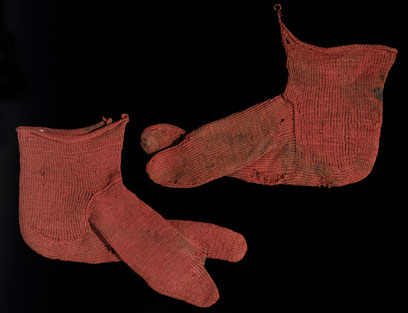
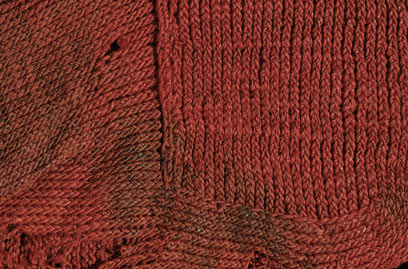
These socks date to the 300s,
and are made by nalbinding. They look very much like
crossed-stitch or twisted-stitch knitting.
As a fine example of the nalbinding/knitting
confusion, the famous (notorious?) Dura-Europos fragment
is considered by many to be the oldest fragment of knitting
in existence. Found in the Indus River Valley and dating
back several thousand years, it is listed in many books
and the original dig report as knitting (I sincerely
wonder if they HAD a knitter on the original dig.) Barbara
Walker has even written a pattern so we can all knit
something historical. Unfortunately, the Dura-Europos
fragment has been proven to be made of nalbinding. Still,
the knit version would make a cool pair of socks.
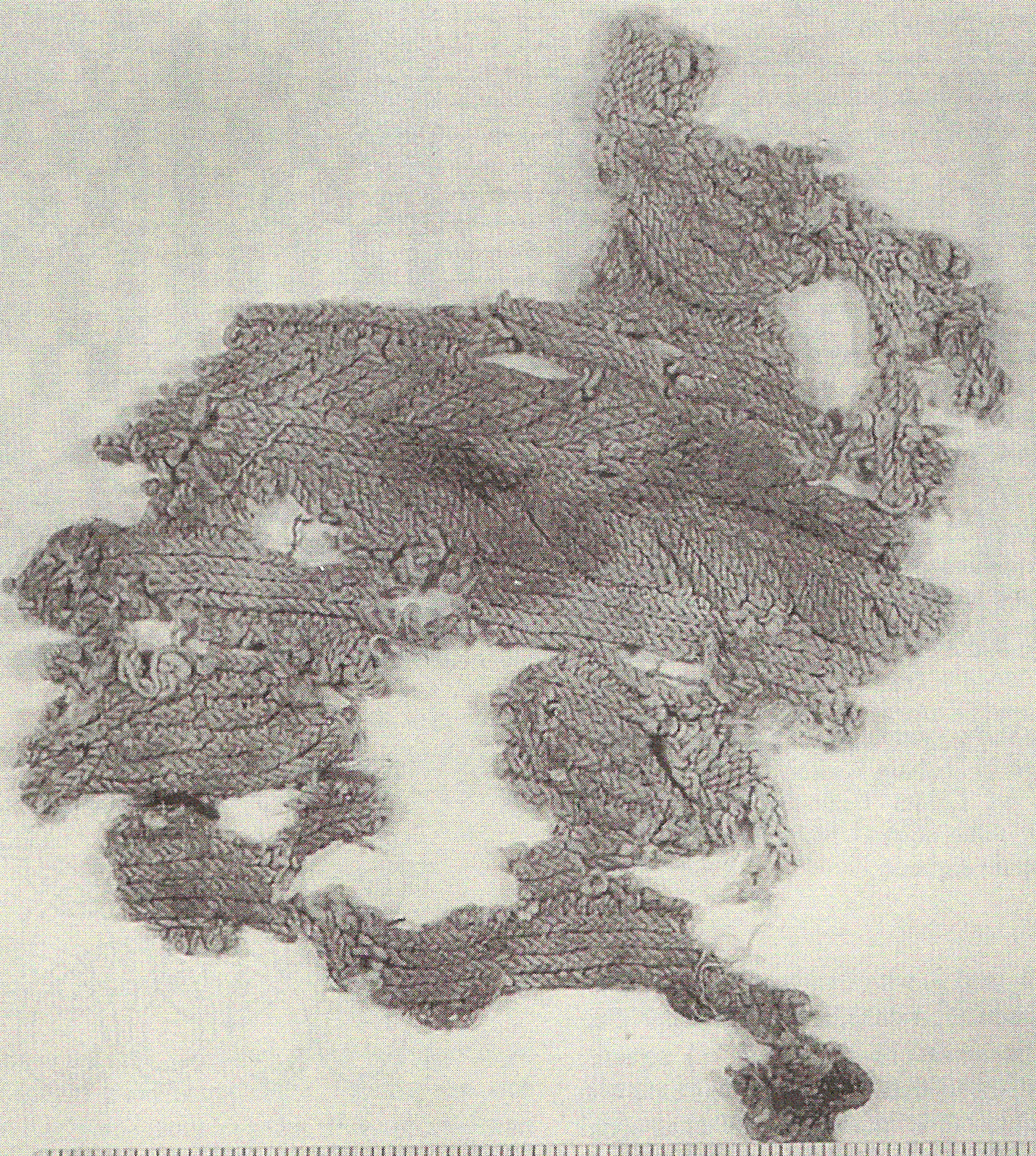
Image from "A History of Hand Knitting" by Richard Rutt,
p 30.
Fragment currently at Yale University.
The oldest REAL knitting (formed
on two sticks by pulling loops through loops) we've
got is 'Coptic socks' from Egypt, dating to around the
year 1000 CE. There are quite a few fragments, all of
them done in shades of white and indigo, in stockinette.
Many of them have Khufic (a decorative Arabic script)
blessings knit into them, or symbols to ward off evil,
or both. All look really cool. And may I point out for
the fiber-snobs among us, that all of the really ancient
knitted fragments we've got are knit out of cotton.
Yes indeedy, cotton. Wool wasn't used for knitting until
way later.
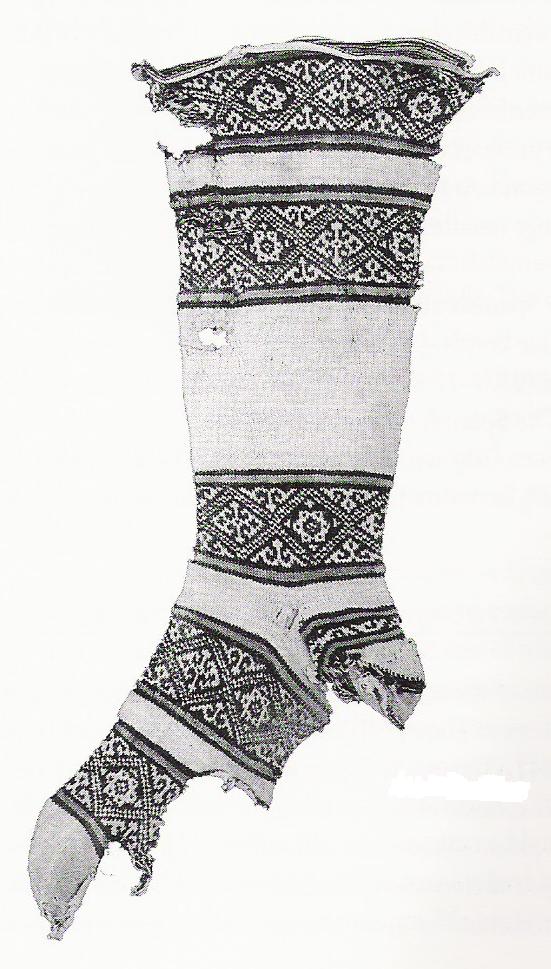 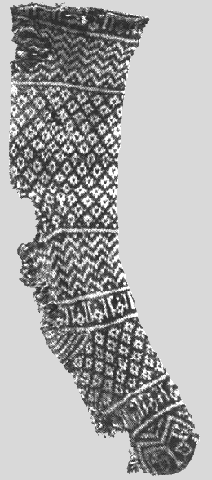
Here are some of the earliest sock fragments we've found.
You can see the patterns are already quite complex.
From "Folk Socks" by Nancy Bush, p. 13 and this
page.
These socks bring me (and more
importantly real, trained archeologists) to a conclusion;
knitting's probably a little older than we think, because
the first fragments we've got are good-looking, well-made,
complex designs. To put it another way, would YOU do
stranded-color socks as your first project, particularly
if you were making it up as you went and had no one
to teach you? With that in mind, given our thousand-year-old
fragments, knitting might be eleven hundred, twelve
hundred years old, allowing for a lifetime or two for
people to invent the methods and then get fancy with
them. It pains my history-obsessed heart to admit it,
but knitting's a recent invention (put against the backdrop
of all of human history, anyway).
Among some historians (I won't
name names), there seems to be a lot of, um, denial
going on about where knitting was developed. There is
a fairly obvious trail of artifacts from Egypt to Moorish-occupied
Spain, and up into the rest of Europe. Some rather Eurocentric
types claim this isn't evidence enough to 'prove' that
knitting was invented in the Middle East, so I'll pile
on a few more points in favor of a Middle-Eastern invention
of knitting. Keep in mind we're discussing the Middle
Ages.
The first dateable hunk of knitting
found in Europe is from Spain (the Spain that was, at
the time, held by Arabic peoples), in a tomb that was
sealed up in 1275, slap in the middle of the darkest
of the Dark Ages. And YET, all of the early knitting
fragments have writing knit into them. Many of the sock
fragments have 'Allah' knit in bands around them, assumed
to function as a blessing. The pillow in Spain has 'blessing'
in a decorative Arabic script knit around the edges.
We can pretty safely assume that knitting words into
knitting was done almost from the first, at a time Europe
was largely illiterate. It was the Islamic world that
had wide-spread literacy. No one's gonna convince me
that an illiterate was the one who came up with the
idea to knit words into a sock. So, the early knitting
fragments were produced by someone literate, and most
literate people were found somewhere in the Islamic
world. Particularly literate people with a knowledge
of decorative Arabic scripts.
Added to that, for the first
four or five hundred years of knitting's history, the
most common materials were cotton and silk. Not wool.
Cotton and silk were far easier to come by in the Middle
East than in Europe. If knitting had started in Europe,
I imagine they'd have used wool first. Or maybe linen.
My final proof is how we knit.
Ever notice we work the stitches from right to left?
Ever wonder why? We write left to right... doesn't it
follow that we would KNIT left to right? Only if we
invented it in the first place. Arabic is written from
right to left. I'm betting that our current knitting
method is a holdover from that. (We knit right to left
today because some Arabic person started doing it that
way over a thousand years ago. History is so cool.)
So what do we know? Knitting
kind of appeared, poof, probably in Egypt or an adjoining
land, sometime around 1000CE and spread rapidly, moving
along trade routes into Europe. Another theory holds
that knitting was brought back to Europe during the
Crusades (1095-1291), but I can't imagine the Crusaders
taking time off from raping and pillaging to share sock-making
techniques in the Middle East. Call me a cynic. I can't
imagine a bunch of Arabs taking a break from being attacked
to teach some stinky Europeans how to knit, either.
From the 1275 pillow found in
Spain, things fan out in terms of direction, and speed
up. There are 'clumsily made' gloves from France dating
to the 1200s (someone teaching themselves to knit, having
seen a trade good?) Then liturgical gloves in a German
tomb, dated to 1297, similar to the ones found in the
Victoria and Albert Museum:
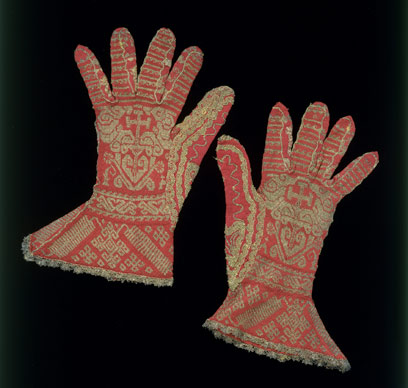
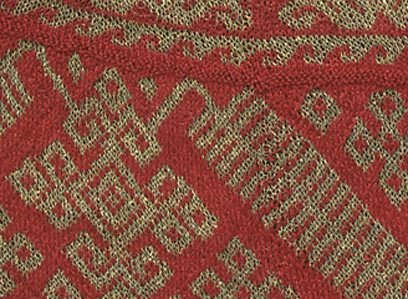
At this stage, knitting was
still a luxury trade item; it was created from imported
silks and cottons, and made into non-vital things like
pillows, liturgical gloves, and small bags.
In the 1350s, paintings called
'knitting madonnas' began to appear. They depict the
Virgin Mary knitting; the paintings are detailed enough
to show that SOMEONE in Europe knew how to knit. The
painting thought to be the earliest of them is found
in Northern Italy (not far from Spain, especially if
you think in terms of trade routes). Another knitting
Madonna was painted in Germany around 1400. The knowledge
of how to knit was starting to spread, quickly.
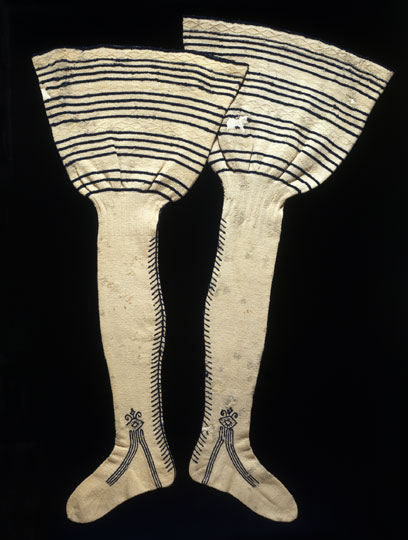 In
the mid-1500s, the first and only major new technique
was introduced to knitting: the purl stitch. First found
on a pair of stockings in a tomb in Toledo, Spain, dated
to 1562. Up until then, all those socks had curly edges.
Can you imagine? In
the mid-1500s, the first and only major new technique
was introduced to knitting: the purl stitch. First found
on a pair of stockings in a tomb in Toledo, Spain, dated
to 1562. Up until then, all those socks had curly edges.
Can you imagine?
By the 1500s, most of the wealthy
in Europe had at least one pair of knit socks (these
were the days of shortie trunk hose and loooong socks
for men, remember), and possibly a knit undershirt or
jacket.
In 1566, King Eric of Sweden
had a garment inventory done; he owned twenty-seven
pairs of silk stockings imported from Spain, each pair
costing the same as his valet's ANNUAL salary (What
a clothes horse! He's lucky he didn't have taxpayers
to answer to).
The gauge on these stockings
was completely insane; Nancy Bush says the gauge of
one pair is 25 stitches and 32 rows PER INCH. Yes, INCH.
This was before the invention of knitting frames or
anything else in terms of automation; these babies were
knit by hand. (For the sake of the knitters, I hope
they were done in direct sunlight, but I'm betting not.
Poor things.)
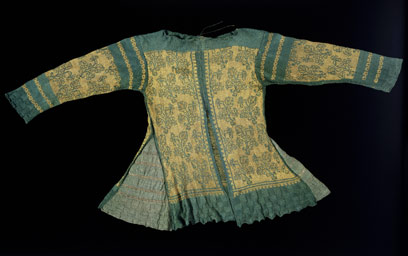  Knitted
jackets and shirts were also popular at this time, usually
knit from silk and gilt threads. (Gilt yarn at the time
was made from actual metal. Can you imagine how fun
THAT was to knit with? It probably tarnished and looked
like crap within the year, too.) Looking at this jacket,
you can see that they were still following woven ideals
for fit and cut. The undershirts are very much like
woven undershirts of the day, something like a modern
Henley, with a longer, flaring shirt tail. Charles the
I of England was said to be wearing one of these undershirts
when he was beheaded in 1649. (Sky blue silk at a gauge
of 8.5 stitches per cm, or about 17 stitches PER INCH.)
Knitting was still pretty exclusive, but not for long.
Economics reared its ugly head, in the form of supply
and demand. Knitted
jackets and shirts were also popular at this time, usually
knit from silk and gilt threads. (Gilt yarn at the time
was made from actual metal. Can you imagine how fun
THAT was to knit with? It probably tarnished and looked
like crap within the year, too.) Looking at this jacket,
you can see that they were still following woven ideals
for fit and cut. The undershirts are very much like
woven undershirts of the day, something like a modern
Henley, with a longer, flaring shirt tail. Charles the
I of England was said to be wearing one of these undershirts
when he was beheaded in 1649. (Sky blue silk at a gauge
of 8.5 stitches per cm, or about 17 stitches PER INCH.)
Knitting was still pretty exclusive, but not for long.
Economics reared its ugly head, in the form of supply
and demand.
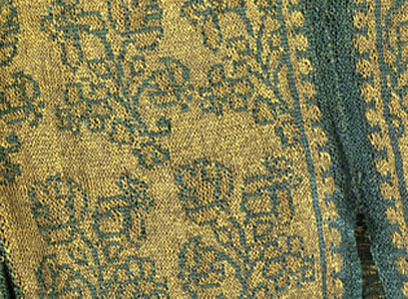
Demand being insanely high,
cottage industries began to appear; a hat-knitting guild
appeared in England in 1424, along with many others
across Europe. Once the common man knew how to knit,
the obvious happened. We started knitting for ourselves.
One of the first of the commonly available knitted products
was the 'acorn hat', made of felted wool. This one dates
to the 1600s. That's right, it took us about five hundred
years to make common 'everyday' knitting out of wool.
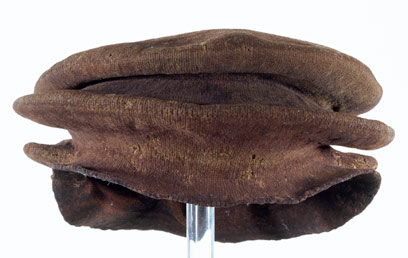
After this, the history is pretty
predictable; the knowledge of knitting spread around
the world, following trade routes. Sailors were big
fans of knitting, since it was small, portable, and
gave them something to do on long voyages. Back in Europe,
the peasants gradually began adding knitting to their
folk costumes, giving us all those lovely ethnic sweaters
we (okay, I) love to knit.
Over the years, the role of
knitting has shifted regularly, from high-demand luxury
item to low-demand folk craft, and back again. In the
Victorian era, knitting became a parlor art, used to
make all sorts of exquisitely fine laces, bags, and
baby clothes. They seem to be the ones who introduced
fine beadwork to knitting, stringing tiny beads onto
sewing thread and knitting it into fabric.
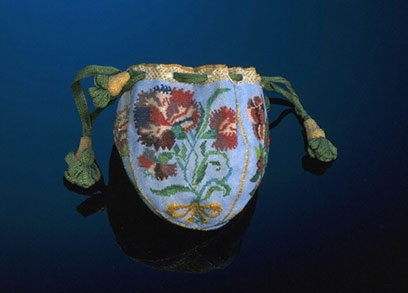
The next revolution in knitting
was the idea of knitwear as sportswear, coming from
two places at once -- British royalty and the Paris designers.
The Prince of Wales began wearing Fair Isle sweaters
to golf in (the one below is similar to his, but no
one knows where the original is, if it still exists).
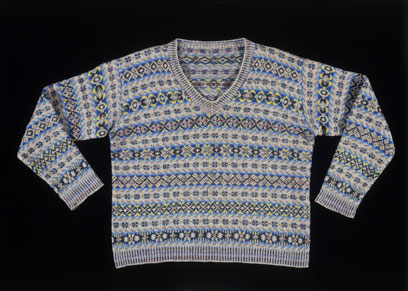
Then Elsa Schiaparelli
mass-produced her 'bow knot' sweater, the crowds went
wild, and the rest is history. (Thankfully. I'd hate
having to wear wovens all the time.)
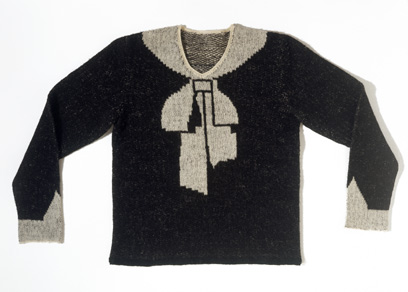
In the 1930s, the depression
hit, and around the world, several co-ops were set up
to help women earn money by knitting. The (deservedly)
most famous of these was Bohus Stickning, founded in
Sweden by Emma Jacobsson. The sweaters are still known
among hard-core knitters like myself, as amazing examples
of color and design, proof that with care and attention,
any craft can be made into art. Below is a photo of
one of their most popular designs, the "Blue Shimmer".
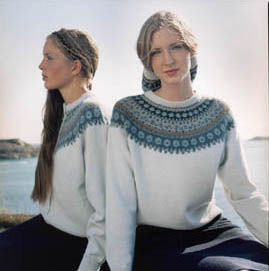 [ [
Blue shimmer photo from the Bohuslans
Museum.
The thing that made knitting
so immediately popular when it was invented, is what
makes it popular even today: it's simplicity. With two
sticks and some string, you can create literally any
article of clothing (And not only is that simple, it's
pretty darn cool). We occasionally add a new technique,
but for the most part knitting is unchanged from twelve
hundred years ago, when some poor nalbinder dumped their
needle and said 'there has to be a better way'. Knitwear
is as popular as ever, if not more so; people learn
to knit daily, and classes are booming. Scientists have
begun knitting nylon arteries to transplant into bodies,
and metallic shields for hoses. It will be interesting
to see what knitting will do next.

NOTES:
All photos from the Victoria
and Albert Museum unless otherwise noted. The V&A
has a great online knitting exhibit available at Victoria
and Albert Museum Knitting Exhibit.
"A History of Hand Knitting"
by Richard Rutt contains a lot of interesting photos
of historical knit pieces, and charts of their patterns.
"Folk Socks" by Nancy Bush not
only has a great history of socks in it, but contains
a lot of modernized patterns for historically significant
socks, including a very nice adaptation of the ancient
Islamic socks.
Vogue Knitting's Winter 2005/2006
issue has a discussion of "Armenian Knitting" the technique
used by Elsa Schiaparelli's knitters to produce the
Bow Jumper. It is written by Meg Swansen and contains
detailed directions and an example pattern.
The Bohus sweater is from the
Bohuslan Museum. According to the site, there are
yarn packs and kits available; I've tried the contact
information and gotten no reply. If anyone else has
information on that, let me know? Otherwise, "Poems
of Color" by Wendy Keele contains a history of Bohus
Stickning and an assortment of patterns and charts.
|

